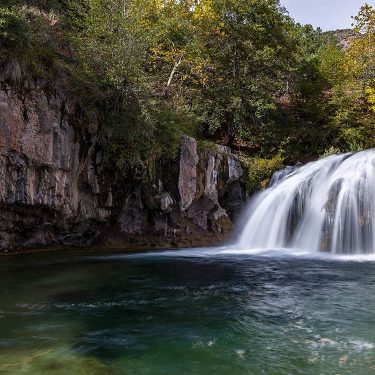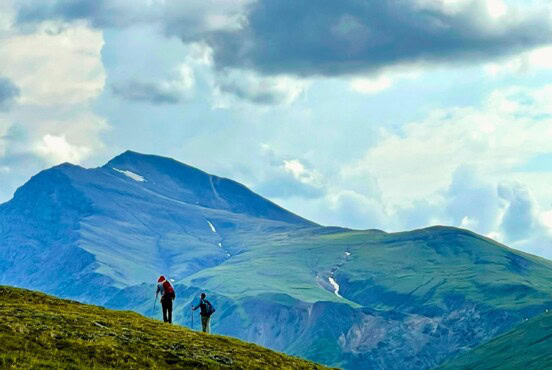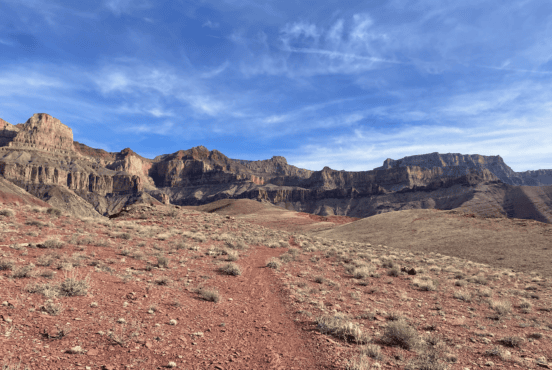Hiking alone can be peaceful, as long as you take this advice from a Vail Mountain Rescue Volunteer who has performed dozens of backcountry rescues.
Setting out in the crisp morning air, the silence of the woods wraps around me like a comforting embrace as I embark on a solo hike. The first few steps of a long trek feel like an eternity, but soon, time and miles melt away. My inner dialogue becomes a soundtrack of clarity and reflection.
Though I’m a social butterfly by nature, I crave the solitude of the forest — a powerful place to mute the world’s noise. Yet, despite feeling at home in the wilderness, a solo adventure can quickly morph into a catastrophe.

Flashback to my high school days: our cross-country team tackled a long trail run on one of Mammoth Lakes best hiking trails, hours away from my Los Angeles hometown. As a beach-loving California kid, I was woefully unprepared for mountain terrain, and our coaches’ minimal guidance didn’t help. I took a wrong turn and found myself lost, without supplies, water, food, or a phone. Fortunately, I encountered a kind older couple who fed me and led me back to the trailhead where my worried team awaited.
That experience taught me invaluable lessons. In the mountains, self-reliance is paramount and preparation is critical. With over 20 years in Colorado, I can proudly say I’ve never been lost again. However, even the most prepared hikers can find themselves alone and in trouble.
With over 50 backcountry rescues and extensive personal experience as an emergency room nurse at Vail Health and Chief of Staff for Vail Mountain Rescue, Emily Cutcliffe Brown knows a thing or two about avoiding solo hiking mishaps. Here are her tips to stay safe while hiking alone.
Use your head and listen to your intuition.
“One of the most important things you can bring [when you’re outdoors] is in between your ears,” advises Brown. When you’re out hiking alone, use your head and follow your instincts.
Hiking alone presents a unique challenge: you’re the sole decision-maker. In a group, there’s collective input and a built-in safety net. If one person calls it quits, the group usually turns around. But when it’s just you, your safety depends on your awareness and judgment. So, what should you do?
Keep your head on a swivel and always be aware of your surroundings. Notice trail markers and natural landmarks to ensure you’re on the right path. Pay attention to what’s happening around and above you in case there are trail hazards or a storm moves in. Additionally, stay sharp so you can make thoughtful decisions.
Above all, trust your instincts. You know that subtle voice inside? It’s usually telling you something. If something feels wrong, stop and assess the situation.

Know your limits
When you’re on the trail, it’s crucial to recognize your physical and mental boundaries. Pushing past them might seem adventurous, but it can quickly turn a peaceful hike into a harrowing ordeal.
You’re the star of this solo adventure, and it’s up to you to ensure you don’t bite off more than you can chew. Listen to your body — it’s your best hiking buddy. Feeling fatigued? Take a break. Facing a daunting ascent? Assess if you’re up for it. Your instincts and awareness are your most reliable guides. So listen to your body’s signals and respect your limits.
Communication is key
When hiking solo, sharing your plan isn’t just a good idea — it’s essential. Brown suggests telling a few people when you plan to start, your actual start time, and when you plan to be back.
But don’t stop there. Let others know not just the trail but your specific route. “We get a lot of calls from people saying their friend was supposed to be back by 4 p.m., but they have no idea which trail they were on,” Brown explains. The more details you provide, the quicker search and rescue teams can pinpoint your location, ensuring help reaches you faster.
Before you set out, ensure your friends and family have all the info they need to find you if things go awry.
Bring several types of fire starters.
Fire is more powerful than you think. Brown carries four fire-starting tools, so if one fails, you have a backup (or two). Her essentials include a lighter, waterproof matches, flint and steel, and several fire starters.
For a DIY firestarter option, try stuffing a toilet paper roll with dryer lint, rubbing petroleum jelly on the outside, and rolling it up with wax paper. It’s lightweight and guaranteed to ignite quickly. Plus, always keep a small plastic bag of toilet paper and paper towels for dry kindling.
Why is fire so crucial?
“Fire can provide so much in the backcountry. It gets very dark very quickly. If you’re not expecting it, it’s easy to lose your bearings. Fire provides light, warmth, a way of cooking food, and wards off animals. But most of all, fire provides people hope,” she explains. “It’s a weird physiological thing, but fire has been a huge part of my rescue tactics.”
On numerous missions, she found that those rescued had lost all hope and refused to move. Brown would start a fire and sit with them, showing compassion until they were ready to go. It wasn’t the rescuers that reignited their spirit — it was the fire.

Navigating the wild and staying on track
When hiking solo, stay aware of your surroundings and always know where you are. As you hike, note natural landmarks you can use for reference on your way back.
“The number one problem we run into is people not correctly navigating the trail,” Brown explains. It’s surprisingly easy to miss a turn and find yourself off the beaten path. Without a map or GPS, disorientation can set in quickly.
A GPS navigation system, whether downloaded on your phone via an app like AllTrails or Gaia or on a GPS device can immediately tell you if you’ve gone off-route. But owning a GPS is only half the battle; knowing how to use it is just as important. At home, power it on, register it, and get familiar with its functions. And always make sure it’s fully charged! A GPS-enabled device has the potential to save the most lives, so consider it an essential part of your solo hiking toolkit.
Don’t forget: technology is fallible. Apps like AllTrails are not perfectand can also get you lost, so use them with caution.
Fuel for the journey
Water is one of the most essential items in your pack, but it’s also one of the heaviest. Carrying all your water isn’t practical if you’re setting out on a long hike. Brown recommends a backpacking water filter to ensure you can always quench your thirst.
Figuring out how much food to pack can be tricky. Aim for 200-300 calories per hour of hiking — closer to 300 for steeper or more technical hikes. On average, a hiker covers 2-3 miles per hour. For a 10-mile hike, you can estimate about 5 hours of moving time, which means packing at least 1,000-1,500 calories worth of food. These numbers will vary based on terrain and individual ability, so use this as a guideline. You know yourself best, so pack accordingly.
Be prepared to rely on yourself
When you’re hiking solo, there’s no one to share snacks with, borrow a beanie from, or ask for a bandage. You need to be fully prepared for anything.
First things first: dress appropriately. Moisture-wicking layers are essential for outdoor safety because they pull sweat away from your skin, regulate body temperature, and keep you dry. “Many people we rescue are in cotton clothing,” says Brown. Cotton is hydrophilic— or water loving — so it retains moisture. Once it gets wet, it stays wet and gets cold. Cold and cotton can be a deadly combination.
Equally important is a moisture protection layer, like a good rain jacket. Weather can be unpredictable, and staying dry is vital to staying warm. A rain jacket and an insulated jacket will keep you dry and toasty.
Proper preparation can make your solo hike a safe and enjoyable adventure. Before you head out, check the weather forecast, plan to start and end early, and be ready for sudden changes. Research your trail, have a plan, and know where you’re going.

What to bring when hiking alone
“There are probably a 100 pounds worth of gear that people will call their ‘must have’ items, but it all comes down to personal preference,” Brown points out. “You might think you know what you would carry for an unplanned night out in the woods, but your pack will change drastically once you actually have an unplanned night in the woods.”
How do you narrow it down? Start with the basics: a first aid kit is non-negotiable. Customize it with items specific to your needs. Extra layers, food, and fire-starting materials are also essential. Beyond that, your packing list will depend on personal preference and your hiking environment. The key is to balance preparedness with practicality, ensuring you have what you need without being weighed down.
What to do when things go wrong
Emergencies happen, even to the most experienced adventurers. So, what should you do when things go wrong?
First and foremost, stay calm. Keeping a cool head in an emergency will help you think clearly. Call for help, then “STAY PUT,” exclaims Brown. “It’s much harder for us to find a moving target.” Hunker down and make yourself comfy and warm until help arrives.
Final thoughts
Embarking on a solo hike is like stepping into a choose-your-own-adventure novel where every twist and turn is yours to navigate. Remember, it’s not just about reaching the summit but savoring the solo journey and the serene solitude that comes with it.
Before you embark on your next hike, lean into your instincts and enjoy the journey. After all, the best stories are written one step at a time.
Seen in: Hiking











